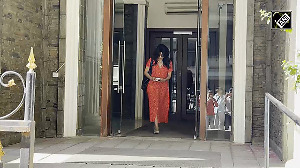Exit polls have been known to go wrong, as in 2004 when all of them were off the mark, with no exceptions. They uniformly predicted an National Democratic Alliance victory but it was the United Progressive Alliance that formed the government. So, for all that anyone knows, the outcome of the elections could be different from what the pollsters say this time. It does seem unlikely, however, that any single party or pre-poll electoral alliance will get a clear majority in the Lok Sabha. The most likely scenario therefore is a patchwork coalition, comprising partners who may not have fought the elections together, and with or without support from the "outside" (in which case it would be a minority government). In such a situation, what is President Pratibha Devi Singh Patil to do?
The Constitution only says that the government must enjoy the confidence of the House. This has been subjected to several interpretations when it comes to coalitions and minority governments (1989 onwards, for the Lok Sabha). Governors have asked for legislators to be paraded before them, to demonstrate a majority; President K R Narayanan asked for a list of MPs to be produced, to demonstrate a majority. And, before him, President R Venkataraman simply went by which party had the largest number of seats, when he invited Rajiv Gandhi to form the government in 1989 and PV Narasimha Rao in 1991 (Gandhi declined, arguing that his interpretation of the election result was that voters had rejected the Congress; Rao led a minority government and defeated a no-confidence vote by bribing MPs).
It is hard to argue that any one method has more merit than the others in all situations, though no one would want MPs paraded in the forecourt of Rashtrapati Bhavan. As the court has decreed in what has come to be known as the Bommai case, if there is to be a test of strength, it should be in the House, not anywhere else. Also, no one would want a repeat of the situation in 1996, when Mr Vajpayee was invited to form the government because he led the largest party. Mr Vajpayee did so, but had to resign 13 days later because he could not muster a majority. And yet, even letters of support that add up to a majority may not be enough; Charan Singh was sworn in as prime minister in 1979 in just such a situation, but had to resign without facing Parliament because he lost his majority very quickly. In short, the specifics of a situation could well influence the decision on what is the best course to adopt. That means the President has some leeway, and is not bound by any one precedent. The country expects that she will exercise due caution and demonstrate good judgment when undertaking the most important task that falls to a President.
An important issue that goes beyond Constitutional proprieties is the time given to whoever is invited to form a government, to demonstrate a majority. There is of course nothing in the Constitution that empowers the President to ask the person chosen as prime minister to prove his or her majority, but that has become a healthy convention. However, far too much time is allowed to lapse between the government being formed and the Lok Sabha being convened--as everyone knows, this is a time used for deal-making, and therefore the time lag should be kept to the bare minimum that is operationally required.






